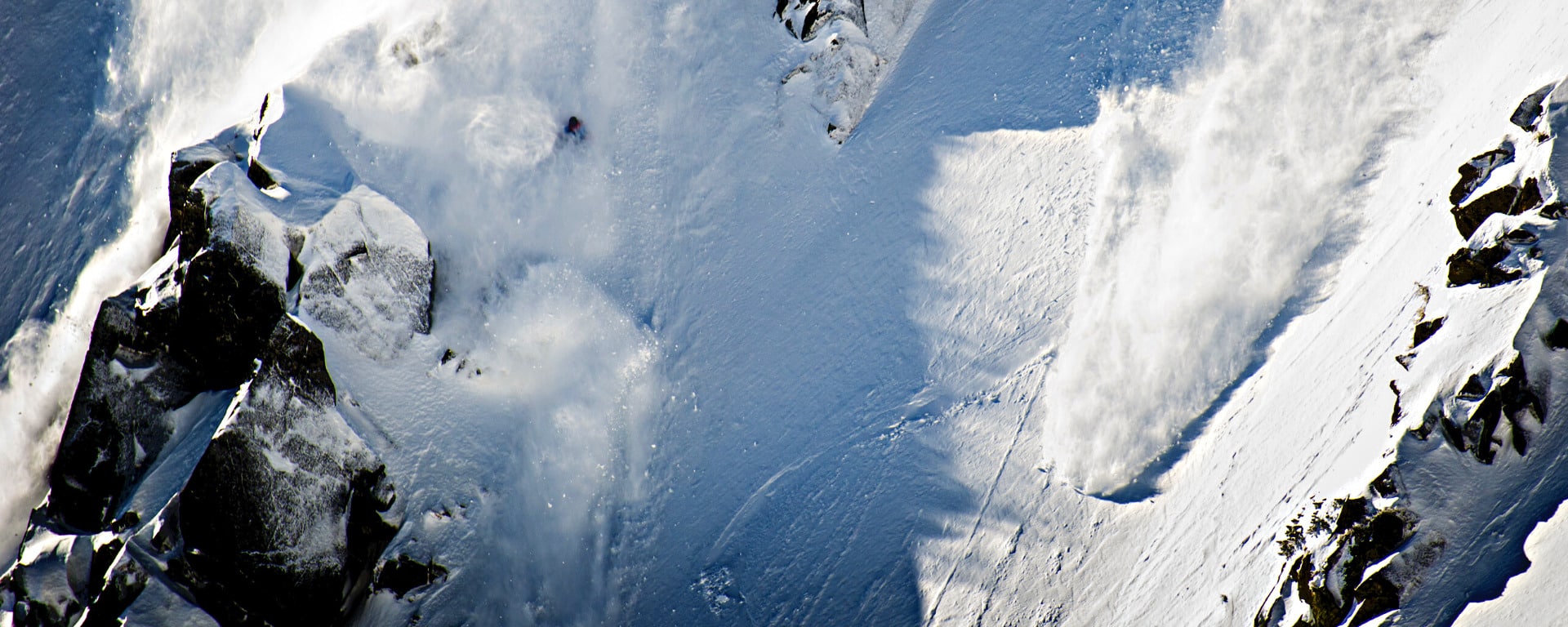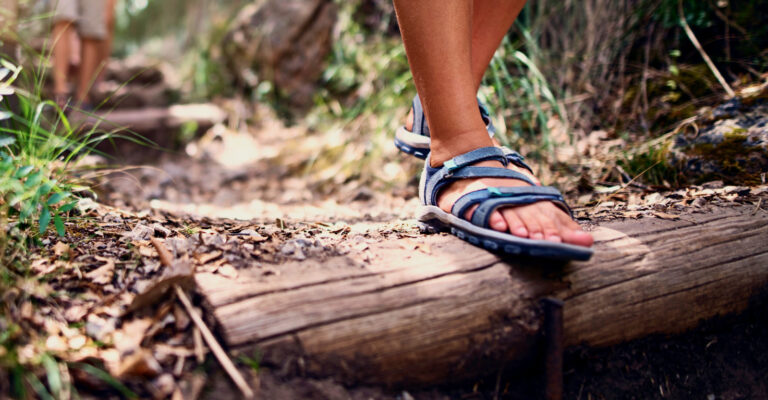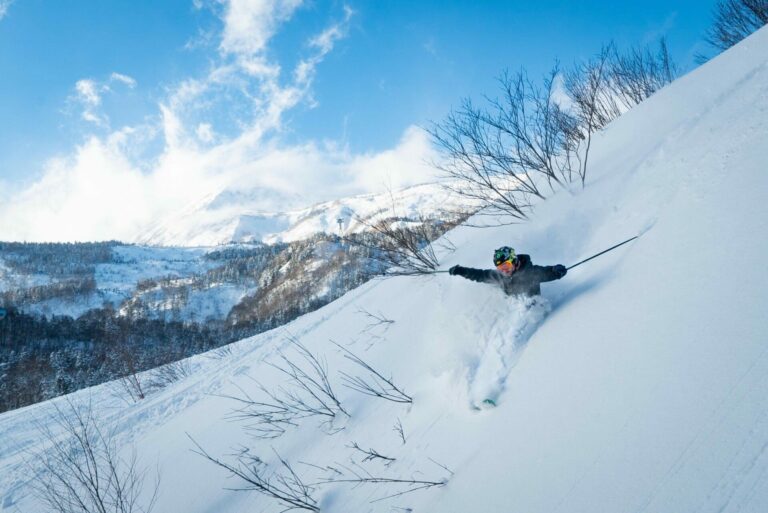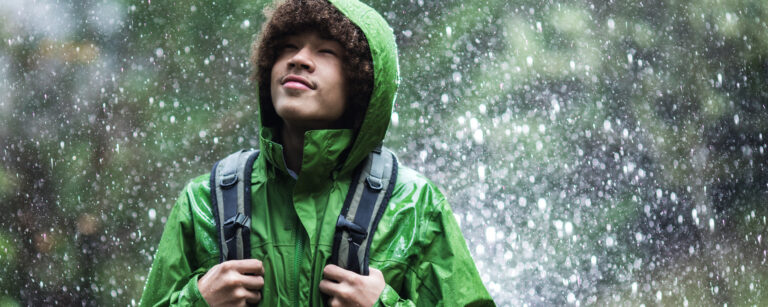Avalanche Safety 101 – Beginner Backcountry Basics
With the rise in popularity of the FreeRide World Tour and countless ski movies. Skiers and boarders dreaming of endless powder skiing laps, are rushing into the backcountry to get a taste without much knowledge of Avalanche Safety. But there is more to skiing outside resort boundaries than ducking a rope or hiking above the top lift.
Inside a ski resort, there is a whole system that keeps you safe. Ski patrol and resort owners manage the terrain inside the resort to ensure avalanches don’t happen. They mark off dangerous areas so you don’t find yourself above a cliff you can’t get down. If something does happen in the resort, Ski Patrol is only a phone call away. Rescue is quick and easy.
When you step outside the resort boundaries, all of that changes. You are responsible for your safety. There is no ski patrol to help if things go wrong. Rescue may be hours and a helicopter ride away, and you may have to find your way out on your own. You can get lost and have to spend the night out in the elements or even have to carry an injured person out to safety.
The backcountry is an amazing place to play but can also be very dangerous. Avalanches are one of the biggest dangers in the backcountry, and they can happen without warning. Fortunately, there are some basic ways to stay safe and avoid avalanches.
So let’s get started.
What is an Avalanche?
An avalanche is a natural or artificially released snow that flows down a hill. Avalanches can occur at any angle, in any type of terrain, at any time of day or night, and in any weather conditions. 27 people die each year in Avalanches in the U.S. alone and many more are caught in non-fatal avalanches.
Where and Why Avalanches Occur?
There are three main factors that determine whether an avalanche will occur. First, the shape of the mountain itself. The terrain features create the setting for a potential avalanche. The terrain does not change. Second, the snowpack conditions. Snow is weather-dependent, meaning it changes constantly. Third, avalanche triggers. A trigger must occur for an avalanche to start. New snowfall, a rockfall, or a person traveling in the backcountry. When a trigger is introduced in the right place at the right time an avalanche may occur.
Avalanche Terrain
Avalanche terrain is determined by the shape and characteristics of the slope. Certain types of terrain are more likely to cause avalanches than others. The slope size, angle and shape of will determine whether snow will slide and whether a slide will continue to propagate once started.
Angle
The angle is the most significant factor when determining the likelihood of an avalanche. Most avalanches occur on slopes between 30 -45 degrees. Below 30 degrees, the slope is not steep enough for a slide to propagate, and above 45 degrees, the slope is too steep to accumulate snow. Unfortunately, slopes between 30-45 degrees are where most skiers and boarders want to ride.
Shape
Slope shape can also play a role in avalanches. A convex slope is more likely to avalanche than a concave slope. Snow on a convex roller is like a paper towel draped over a basketball with someone pulling on both ends. Gravity is pulling on both ends of the snow on the roller. just like someone pulling on the paper towel. If the paper towel becomes weaker (placing a small cut in the paper) it will rip. This is the same as a skier laying a track over a roller and causing the start of an avalanche.
Size
The size of a slope will determine how big an avalanche could be if one were to occur. The bigger the slope the larger the potential avalanche and the greater the consequences of one happening.
Terrain Aspect
The aspect of a slope is the direction that it faces. This is important when considering where to ski as different aspects may have very different avalanche conditions and therefore very different risk profiles. Aspect comes into play when considering the avalanche conditions that exist on a slope. Has wind been blowing snow onto, or off the hill. Is the sun shining on the slope making the snow sun affected?
Terrain Complexity
The terrain you decide to ski is often not straightforward. Are there any terrain traps (areas where you cannot escape from if an avalanche occurs). Is there risk if avalanches occur above you. Are there trees, or cliffs or chutes that would limit your routes of escape. All of these factors need to be considered when determining the risk of avalanche terrain.
Avalanche Conditions
When talking about avalanche conditions we often talk about the snowpack. The snowpack refers to the snow on the ground from the most recent storm up to the oldest settled snow. When snow falls it forms layers similar to a stacked cake. Some of these layers are strong like cake itself, while other layers are weak like the icing between the cakes. An avalanche happens when unstable snow gives way on a slope steep enough for the snow to continue to move.
Snowpack conditions are constantly changing. You need to be aware of these changes and how they will impact the stability of the snow.
New Snowfall
When new snow falls the potential of an avalanche increases significantly. If there is 30 cm or more of new snowfall you should be wary of avalanches. The additional layer of unstable snow on top of a weak lay can cause avalanches. This is why it is important to have a good understanding of the current conditions before heading out into the backcountry.
Wind
Wind can also have a significant impact on the stability of the snow. If wind is blowing snow onto a slope it will build up and the increased weight can trigger an avalanche. The wind can transport snow from one slope to another and create instability. The wind can also scour the snow surface and create a hard crust. This crust can act as a weak layer in the snowpack and potentially trigger an avalanche.
Temperature
Temperature can also have an impact on the snow. If the temperature is too cold the snow will be very brittle and can break easily. If the temperature is too warm the snow will start to melt and become weaker. The freeze thaw cycle in the spring can result in a frozen surface that may create a weak buried layer that can result in an unstable snowpack.
Sun
The sun can also have an impact. When the sun shines on the snow it will start to melt. This can create a weak layer in the snowpack that may trigger an avalanche.
Avalanche Triggers
Skiers and snowboarders are often the biggest trigger for avalanches. When you ski on a slope the snow below you is required to support your weight. The ski pressure on the snow will cause it to break and slide if the snow is not strong enough. A skier’s zone of influence is between 10cm – 1m deep in the snow. If there is a weak layer present within 1m depth and the correct slope conditions a skier can initiate an avalanche. This is why backcountry skiers dig snow pits to examine the snowpack and determine what the potential risks are on a given aspect.
How To Mitigate Avalanche Risk
The only control we truly have over an avalanche is ourselves and our behaviour. We cannot change the shape of a mountain, nor can we control the weather. To mitigate avalanche risk, we must control ourselves.
Take an Avalanche Safety Class
One of the best ways to reduce your risk in the backcountry is to take an avalanche safety class. Avalanche education will provide you with the skills and knowledge necessary to make informed decisions when travelling in avalanche terrain.
Avalanche Safety Training 1 (AST1)
The AST1 course is the entry level avalanche safety course. This avalanche course is designed to provide you with the basic knowledge and skills necessary to travel safely in the backcountry. The course will cover topics such as terrain selection, route finding, snowpack analysis, and hazard recognition.
American Avalanche Institute Level 1 (AAI Level 1)
The AAI Level 1 course is designed for those who want to gain a deeper understanding of avalanches. This course will cover topics such as snowpack analysis, terrain selection, rescue, and decision making.
Both the AST1 and AAI Level 1 courses are offered by a variety of schools across North America. For a complete list of schools, please visit the avalanche.org website.
Online Resources
Avalanche.org – www.avalanche.org
Avalanche Canada – www.avalanche.ca
Avalanche Safety Gear
Avalanche safety gear is essential to keeping you safe in the backcountry. The most important piece of gear is an avalanche transceiver. An avalanche transceiver is a device that emits a signal that can be picked up by other transceivers. If you are buried in an avalanche, your transceiver will allow rescuers to find you more quickly.
Beacon
A beacon is a device that you wear on your body that emits a signal. If you are buried in an avalanche, your beacon will allow rescuers to find you more quickly. Beacon checkers are devices that you can use to test your beacon to make sure it is working properly.
Probe
A probe is a long, thin pole used to probe the snow to find someone buried in an avalanche. Probing is a method of search that is used when rescuers are trying to find someone who is buried in an avalanche.
Shovel
A shovel is a tool that is used to dig someone out who is buried in an avalanche. It is important to have a shovel that is strong and durable, and that can be used to dig quickly.
Backpack
A backpack is a bag you wear on your back that is used to carry all your gear. It is important to have a backpack that is big enough to fit all of your gear, but not so big that it is cumbersome to carry. There are also Avalanche Airbag Backpacks that will help to keep you safe in the event you get caught in an Avalanche.
Read The Avalanche Report
An avalanche report is a crucial tool that backcountry users rely on to make informed decisions about travel in avalanche terrain. The report is produced by experts and contains information about the current conditions, as well as the avalanche forecast for the next few days. The report will also often contain information about specific areas that are of concern. Each country has their own version of the avalanche report, so be sure to check the report for the area you are planning to travel in.
- In Canada, the avalanche report is produced by Avalanche Canada and is available at www.avalanche.ca.
- In the United States, the avalanche report is produced by the National Weather Service and is available at www.weather.gov/safety
- In Japan the avalanche report is produced by the Japan Avalanche network and is available at http://nadare.jp/
- In Europe the avalanche report is produced by the European Avalanche Warning Service and is available at eaws.info
Choose Who You Ski With
When skiing in the backcountry one of the most important things you can do is choose who you go with. If you get into trouble in the backcountry it’s the people who are with you who will dig you out! Make sure that you go with someone who is experienced and knows the area well. If you are new to the backcountry, it is best to go with a guide or an avalanche course instructor.
Check The Weather
Before heading out you need to check the weather not only the forecast, but also the weather history for at least the past week. The weather history will help you determine what the snowpack may look like. It will give you an idea if there are any potential weak layers at depth, and which aspects to look out for. (This information should also be in the avalanche report).
Looking ahead to the weather forecast will tell you how conditions may change during your tour. Will the temperature rise, will it drop, how will that impact the snowpack. Is there a large snowfall expected, is there any potential issues with wind? All of these things can impact the safety of your tour.
Checking the avalanche forecast is not enough, you also need to check the weather!
Choose Your Route
The best way to prevent an accident is to avoid avalanche terrain. Before going into the backcountry you should plan your trip and choose your terrain. When choosing your terrain, you need to think about the avalanche danger and the type of skiing or riding you want to do. If you are new to the backcountry it is best to choose lower angle terrain that is not exposed to avalanches. As you gain experience you can start to venture into steeper, more challenging terrain.
Be sure to let someone know where you are planning on going and when you plan to come back.
Group Management
Group management is an important part of enjoying the backcountry. Radios can be a helpful tool to manage larger groups if needed. When hiking/traveling in the backcountry you should always be aware of the terrain above you. When passing through higher risk areas, space the group so that only 1 person is at risk at a time (this way there is always someone ready to rescue if needed). Before dropping in, assess the terrain risk. Identify safe havens and lines of escape.
When in a group it can be easy to simply defer to the group. Studies of past incidents show that it is common for people to ignore risks and simply defer to the group leader. If you feel unsafe, or something does not look right, speak up! It is always better to err on the side of caution.
Final Thoughts
Avalanches can be dangerous and deadly, but with the proper training and knowledge they can be avoided. Studying avalanches and understanding how they work can take a lifetime. Fortunately through training and guided experience many people can learn to safely enjoy the mountains. The guide above is an introduction to backcountry safety. If after reading you are interested in learning more, start by taking a backcountry course and a guided tour. Classroom and internet learning can only take you so far. To truly understand and stay safe in the backcountry only experience can teach you what you need to know.
FAQ
How do you stay safe in an avalanche?
The best way to stay safe in an avalanche is not to get in one in the first place. Planning, training and observation will help you choose the best terrain.
If however you do find yourself in an avalanche, try and ski out of the avalanche path at a 45 degree angle to your island of safety. If you cannot get out of the avalanche, get rid of your skis and poles and try to float/swim to the surface of the avalanche as best you can. If you have an avalanche airbag deploy it. If as the avalanche slows you find yourself buried try and create a space around your face and chest with your arms. This will create an air pocket and will increase your chances of survival. Try to stay calm and wait for rescue.
Can you breathe if buried in an avalanche?
There is some air around you when buried in an avalanche. If you are buried in an avalanche it is important to try and create an air pocket around your face. This will give you a chance to breathe until rescue comes. Time is of the essence when buried in an avalanche so it is also important to try and signal for help.
What is the avalanche hazard?
The avalanche hazard is the risk of being caught in an avalanche. The hazard is determined by a number of factors including the slope angle, the type of snow, the weather, and whether there are any obstacles in the path of the avalanche.








